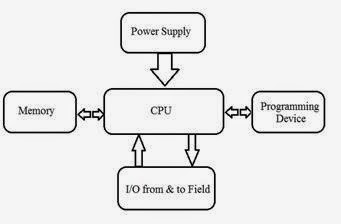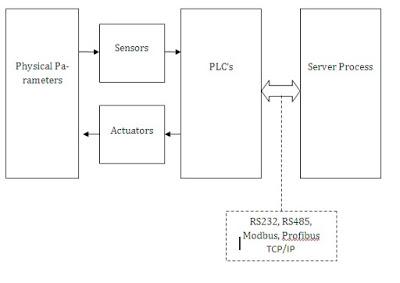Abstract— In today’s modern world the industrial sector has shifted from the classical methods of Control and Automation to the state of the art techniques like wireless Networks. These encouraged to industries to attain a higher growth and production, with greater Quality as well as quantity which consequently gave rise to reduction in costs of the products. This type of automation is gaining popularity at a very slow pace due to huge initial costs associated with it. This problem can be resolved by promoting ZigBee based wireless Networks interfaced to Programmable Logic Controllers for state of art control in industrial automation, which might encourage the industries to take the path of modern Wireless Cost effective automation. This paper focuses
on the most widely used wireless standard in Wireless Sensor Networks, a ZigBee technology and its role in Industrial Factory Automation. So there is a great potential of Wireless Sensor Network in industrial, consumer and commercial application. Also this paper shows efforts of role of ZigBee in various industrial applications.
on the most widely used wireless standard in Wireless Sensor Networks, a ZigBee technology and its role in Industrial Factory Automation. So there is a great potential of Wireless Sensor Network in industrial, consumer and commercial application. Also this paper shows efforts of role of ZigBee in various industrial applications.
Keywords—Industrial Automation, Programmable Logic Controller, ZigBee based wireless Networks, ZIGBEE based Automation System.
I.
Introduction
Introduction
Industrial Automation technologies with wireless Network such as Industrial Distributed Control System (DCS), Factory automation and industry automation technologies are rapidly changing due the recent development of Solid State Electronics. One of the most promising protocols for wireless networking and Factory automation is ZigBee based automation. The ZigBee has advantage of low power consumption, low cost, and support for various cluster automation network configurations. IEEE 802.15.4 protocol, which describes MAC and Physical layer of the ZigBee [2]
protocol stack, is thought up to be used in special purpose systems, since they require low consumptions and do not necessitate an high transmission speed. ZigBee is one of the new technologies enabling Wireless Personal Area Networks (WPAN). ZigBee gives a specification for a suite of high level communication protocols using small, low-power digital radios based on the IEEE 802.15.4 standard [3].
protocol stack, is thought up to be used in special purpose systems, since they require low consumptions and do not necessitate an high transmission speed. ZigBee is one of the new technologies enabling Wireless Personal Area Networks (WPAN). ZigBee gives a specification for a suite of high level communication protocols using small, low-power digital radios based on the IEEE 802.15.4 standard [3].
Fig.1.Tarang ZigBee
The
technology is simpler and cheaper than other WPANs such as Bluetooth technology. ZigBee protocols are provided for use in various embedded applications requiring low data rates and low power consumption. Though WPAN covers only a few meters, 30 feet in thecase of ZigBee; the network will have several layers, so designed as to enable intrapersonal communication within the network, connection to a network of higher level and ultimately an uplink to the Web [4].
PLC’s are solid state devices used to control process or machines.Theycanstore instructionslike
sequencingcounting,timing, arithmetic,datamanipulationandcommunication [7]. A PLC is an example of a
hard real time system since output results must be produced in response to input conditions within a bounded time, otherwise unintended operation will result. PLC reads the status of the external input devices, e.g. Keypad, sensor,
switchandpulses,andexecutebythe microprocessorlogic,sequential,timing,counting and arithmetic
operations according the status of the inputsignalsaswellasthepre-writtenprogram stored inthe PLC [8].
The generated outputs are sent tooutputdevicesastheswitchofarelay electromagneticvalve,motordrive,controlof a machine or operation of a procedure for the purpose of machine automation or processing procedure.
sequencingcounting,timing, arithmetic,datamanipulationandcommunication [7]. A PLC is an example of a
hard real time system since output results must be produced in response to input conditions within a bounded time, otherwise unintended operation will result. PLC reads the status of the external input devices, e.g. Keypad, sensor,
switchandpulses,andexecutebythe microprocessorlogic,sequential,timing,counting and arithmetic
operations according the status of the inputsignalsaswellasthepre-writtenprogram stored inthe PLC [8].
The generated outputs are sent tooutputdevicesastheswitchofarelay electromagneticvalve,motordrive,controlof a machine or operation of a procedure for the purpose of machine automation or processing procedure.
The paper is organized as follows. Section II gives automation type. Section III gives programmable logic controller. Section IV presents ZigBee architecture. In section IV industrial applications review is presented. The conclusions
presented in section V.
presented in section V.
II.Automation
Automation is the process of to control systems (such as numerical control, programmable logic control, and other industrial control systems), in concert with other applications of information technology (such as computer-aided
technologies (CAD, CAM), to control industrial machinery and processes, reducing the need for human intervention. In the scope of industrialization, automation is a step beyond mechanization. Whereas mechanization provided human
operators with machinery to assist them with the physical requirements of work, automation greatly reduces the need for human sensory and mental requirements as well. Processes and systems can also be automated. Specialized
hardened computers, referred to as programmable logic controllers (PLCs), are frequently used to synchronize the flow of inputs from (physical) sensors and events with the flow of outputs to actuators and events. This leads to
precisely controlled actions that permit a tight control of almost any industrial process. There exist two types of automation wired and wireless automation [5].
technologies (CAD, CAM), to control industrial machinery and processes, reducing the need for human intervention. In the scope of industrialization, automation is a step beyond mechanization. Whereas mechanization provided human
operators with machinery to assist them with the physical requirements of work, automation greatly reduces the need for human sensory and mental requirements as well. Processes and systems can also be automated. Specialized
hardened computers, referred to as programmable logic controllers (PLCs), are frequently used to synchronize the flow of inputs from (physical) sensors and events with the flow of outputs to actuators and events. This leads to
precisely controlled actions that permit a tight control of almost any industrial process. There exist two types of automation wired and wireless automation [5].
·Wired Automation
·Wireless Automation
The demand for wireless technology in home automation systems has recently been increasing due to several advantages such as installation cost reduction, easy placement, easy extension, aesthetic benefits, and mobile device connectivity. Among the many wireless technologies available, ZigBee is one of the most useful for home automation. A wireless home networking system can be configured using ZigBee alone [7].
Wireless technology spans a distance beyond the capabilities of typical wiring. It can provide a backup communications link in case of normal network failure, link portable or temporary workstations, wireless technology can overcome situations where normal cabling is difficult or financially impractical. In wireless technology fault finding is easy as compared to wired technology.
III. Programmable logic controller (PLC)
A PLC is a programmable logic controller which is known as digital computer used to automate industrial processes, such as control of machinery on factory assembly lines. Unlike the general purpose computers, the PLCis designed for multiple input and multiple output arrangements, extended temperature ranges, immunity to electrical noise, and resistance to vibration and impact. PLCs have been gaining popularity on the factory floor and will probably remain predominant for some time to come. Most of this is because of the advance they offer: cost effective, flexible, reliable, etc.[6]

Fig.2. PLC Block Diagram
Fig. 2 shows block diagram of PLC. A small PLC has a fixed number of connections built in for inputs and outputs. Expansion are available if the base model does not have sufficient I/O. Programs to control machine operation are typically stored in battery-backed RAM or other non-volatile flash memory. These PLC programs are typically written in a special application on a personal computer, and then downloaded to the PLC over a cable. The PLC can Preprogrammed several times, thus making it adaptable to the process changes required by the company/organization [13].
·ZigBee & PLC Controlled Batch Process
ZigBee acts as transceiver. A pair of ZigBee transmitter and receiver is used where wireles exchange of data takes place and hence two way communication is done. The application “Monitoring” takes place at the field/process site. It is placed in a remote area and consists of sensors and actuators [1].
The process controlled in the project using a PLC is a Batch process used to manufacture a chemical and the parameters to be controlled and measured is level.
Benefits of Batch Process
·A batch process can be used to automate much of the work.
·Batch processing can save time and energy by automating repetitive tasks.
·Batch time can be adjusted to meet quality specs
·Slow dynamics permit real-time calculations
The BATCH PROCESS setup is placed in a remote area (field/process site) and is controlled from the control room wirelessly using TARANG ZigBee where PLC, SCADA and the control panel are placed. The process is controlled through
SCADA&PLC in auto mode and can also be controlled in manual mode. The process can be controlled and monitored directly from SCADA and also from the control panel [1].
SCADA&PLC in auto mode and can also be controlled in manual mode. The process can be controlled and monitored directly from SCADA and also from the control panel [1].
The main components are TARANG ZigBee and PLC which control the whole process. The TARANG is used as the source and which is used in direct mode. PLC is used to control and monitor the batch process [1].
IV. Zigbee architecture
The ZigBee Standard has evolved standardized sets of solutions, called ‘layers’.[4] These layers facilitate the features that make ZigBee very attractive: low cost, easy implementation, reliable data transfer, short-range operations, very
low power consumption and adequate security features. Fig. 3 shows layered architecture.
low power consumption and adequate security features. Fig. 3 shows layered architecture.
Network layer:
Network layer interfaces between application layer and MAC Layer. This Layer is responsible for network formation and routing. Routing is the process of selection of path to relay the messages to the destination node. This forms the
network involving joining and leaving of nodes, maintaining routing tables (coordinator/router), actual routing and address allocation. ZigBee coordinator or router will perform the route discovery. This layer Provides network wide
security and allows low power devices to maximize their battery life. From the basic topologies, there are three network topologies are considered in IEEE802.15.4 are star, tree Network and mesh [8].
network involving joining and leaving of nodes, maintaining routing tables (coordinator/router), actual routing and address allocation. ZigBee coordinator or router will perform the route discovery. This layer Provides network wide
security and allows low power devices to maximize their battery life. From the basic topologies, there are three network topologies are considered in IEEE802.15.4 are star, tree Network and mesh [8].
ApplicationSupport layer:
The application Layer is the highest protocol layer and it hosts the application objects. ZigBee specification separates the APL layer into three different sub-layers: the Application Support Sublayer, the ZigBee Device Objects, and
Application Framework having manufacturer defined Application Objects.
Application Framework having manufacturer defined Application Objects.
·The application objects (APO):This part of layer controls and manages the protocol layers in ZigBee device. It is a
part of software which controls the hardware. Each application objects assigned unique end point number that other APO’s can use an extension to the network device address to interact with it.
part of software which controls the hardware. Each application objects assigned unique end point number that other APO’s can use an extension to the network device address to interact with it.
·ZigBee Device Object: The key definition of ZigBee is the ZigBee device object, which addresses three main
operations; service discovery, security and binding. The role of discovery is to find nodes and ask about MAC address of coordinator/router by using unicast messages.
operations; service discovery, security and binding. The role of discovery is to find nodes and ask about MAC address of coordinator/router by using unicast messages.
·Application support sub layer: The Application Support (APS) sub layer provides an interface between the NWK and the APL layers through a general set of services provided by APS data and management entities.
·Security service provider: ZigBee provides security mechanism for network layer and application support layers, each of which is responsible for securing their frames [8].
Physical layer: The physical layer of the IEEE802.15.4 standard is the closest layer to the hardware, which control and communicate with the radio transceiver directly. It handles all tasks involving the access to the ZigBee hardware, including initialization of the hardware, channel selection, link quality estimation, energy detection measurement and clear channel assessment to assist the channel selection. The IEEE 802.15.4 physical layer accommodates high levels of
integration by using direct sequence to permit simplicity in the analog circuitry and enable cheaper implementations[7].Supports three frequency bands, 2.45GHz band which using16 channels,915MHz band which using 10 channels and 868MHz band using 1 channel. All three using Direct Spread Spectrum Sequencing (DSSS) access mode [8].
integration by using direct sequence to permit simplicity in the analog circuitry and enable cheaper implementations[7].Supports three frequency bands, 2.45GHz band which using16 channels,915MHz band which using 10 channels and 868MHz band using 1 channel. All three using Direct Spread Spectrum Sequencing (DSSS) access mode [8].
Media access control layer:
This layer provides interface between physical layer and network layer. The MAC data service enables the transmission and reception of MAC protocol Data Units (MPDUs) across the PHYdata service. This provides two services; MAC data
services and MAC management service interfacing to the MAC sub Layer Management Entity (MLME) Service Access Point called (MLME-SAP). MAC layer is responsible for generating beacons and synchronizing devices to the beacon signal in a beacon enabled services [8].
services and MAC management service interfacing to the MAC sub Layer Management Entity (MLME) Service Access Point called (MLME-SAP). MAC layer is responsible for generating beacons and synchronizing devices to the beacon signal in a beacon enabled services [8].

Fig.3. 802.15.4 ZigBee Stack Architecture
ZigBee is
the wireless technology falls in the category of wireless domain like GSM and RF technology. It indicates that ZigBee reduces the cost and maintenance of the wires used for connections. Thus ZigBee replaces the wired technology and
provides a wireless communication [1].
the wireless technology falls in the category of wireless domain like GSM and RF technology. It indicates that ZigBee reduces the cost and maintenance of the wires used for connections. Thus ZigBee replaces the wired technology and
provides a wireless communication [1].
As the wireless PLCs use modem for transmitting signals from PLC to the process here we are using ZigBee as the communication interface which is used for transmitting and receiving the signals from the PLC to process and vice-versa.ZigBee is a wireless network developed as an open global standard to address the unique needs of low-cost and low-power wireless personal area networks (WPANs). This wireless network uses full advantage of 802.15.4.
V.Industrial Application Review
Following are some of the Industrial applications discussed.
·Industrial Automation by ZigBee Based Wireless Remote Controller:
In this application an integrated remote controller is used to control electric appliances in the home with no extra attachment of communication device to the appliances, using ZigBee protocol and infrared remote controller technology. It is cost effective technology for any home appliance by using ZigBee protocol as a wireless communication technology[12].
·Real Time ZigBee Based Network for Home Automation Environment.
In this application it is shown that a two-tiered architecture designed to connect nodes that exchange messages with Real-Time constraints within a Home and Building Automation. The architecture model here proposed solves the problems of limited transmission range of the IEEE 802.15.4/ZigBee protocol, allows to control and monitor the various devices in a centralized approach both locally and remotely (using the Internet access) [11].
·Water Level Control System Using PLC andWireless Sensors
In this application describes designed and implemented a water level control system based on the usage of PLC system and wireless sensors. One of the main advantages of using a design based on PLC is the simplicity, flexibility and
reliability in comparison with other classic control solutions. The study tests were performed by using an experimental SIEMENS LOGO! 24RL PLC system. In this paper are presented two water level measurement systems, one uses resistive electronic sensors, contactors and a contactor coil that turns off the water pumping installation, and the other one uses wireless sensors and a PLC. The main disadvantage of contactor is the reduced capacity of resisting to
overloads and short-circuits; this disadvantage can be eliminated by using ultra fuses. The system based on PLC and wireless sensors is cost effective and allows easy customization. Nowadays PLC and wireless sensors based systems
represent modern solutions that are suitable for controlling the time driven event systems such as the case of water tank control [9].
reliability in comparison with other classic control solutions. The study tests were performed by using an experimental SIEMENS LOGO! 24RL PLC system. In this paper are presented two water level measurement systems, one uses resistive electronic sensors, contactors and a contactor coil that turns off the water pumping installation, and the other one uses wireless sensors and a PLC. The main disadvantage of contactor is the reduced capacity of resisting to
overloads and short-circuits; this disadvantage can be eliminated by using ultra fuses. The system based on PLC and wireless sensors is cost effective and allows easy customization. Nowadays PLC and wireless sensors based systems
represent modern solutions that are suitable for controlling the time driven event systems such as the case of water tank control [9].
·Wireless Machine Monitoring And Control For Educational Purpose
This application gives knowledge of educational pneumatic machine with replacement of Programmable Logic Controller that being used before to control part or pneumatic and electro pneumatic components using Data Acquisition Card (DAQ) and ZigBee network for wireless communication. SCADA measurement is done with NI LabVIEW as software with analysis and a customized user interface. The complete automation process did show that machine monitoring and control using LabVIEW and DAQ is reliable and easy to use software for GUI applications [10].
VI.
Conclusion
The review on a ZigBee and its applications in industrial automation system is presented. Paper focuses on traditional automation methods and advanced wireless networks so as to might encourage the industries to take the path of
modern Wireless Cost effective automation so there is a great potential of Wireless Sensor Network in industrial, and many other commercial applications.
modern Wireless Cost effective automation so there is a great potential of Wireless Sensor Network in industrial, and many other commercial applications.
ACKNOWLDGEMENT
The authors would like to thank reviewers of this paper for their valuable comments and also to the sponsored company.
References
[1]KaushikBhuiya, KintaliAnish, “Low cost wireless control and monitoring usingPLC and SCADA”, International Journal of Scientific and Research Publications, VolumeIssue 9, September 2013 ISSN 2250-3153.
[2]BhavneetSidhu, Hardeep Singh, and AmitChhabra, “Emerging Wireless Standards – WiFi, ZigBee and WiMAX”, World Academy of Science, Engineering and Technology 25 2007
[3]S.S.Bidwai, V.B.Kumbhar. “Real Time Automated Control using PLC-VB Communication” International Journal of Engineering Research and Applications (IJERA) Vol. 3, Issue 3, pp.658-661 (Jun 2013).
[4]T.Kalaiselvi, R. Praveen, Aakanksha R.Dhanya.S, “PLC BasedAutomaticBottle FillingandCappingSystemWithUser DefinedVolumeSelection,”
IJETAE., Volume 2,Issue 8, (August 2012).
IJETAE., Volume 2,Issue 8, (August 2012).
[5]Dr.D.V.PushpaLatha, “Simulation of PLC based Smart Street Lighting Control using LDR” International Journal of Latest Trends in Engineering and Technology (IJLTET)
[6]Woo Suk Lee, Seung Ho Hong, “Implementation of a KNX-ZigBee gateway for home automation” ISCE ’09. IEEE 13th International Symposium on, 2009.
[7]Francesca Cuomo, Sara Della Luna, Ugo Monaco, TommasoMelodia, “Routing in ZigBee: benefits from exploiting the IEEE 802.15.4 association tree”, IEEE Communications Society subject matter experts for publication in the ICC 2007 proceedings.
[8]Nisha Ashok Somani and Yask Patel, “zigbee: a low power wirelessTechnology for industrial Applications”, International Journal of Control Theory and Computer Modelling (IJCTCM) Vol.2, No.3, May 2012.
[9]CosminaIlles, Gabriel NicolaePopa and IoanFilip, “Water Level Control System Using PLC and Wireless Sensors”, IEEE 9th International Conference on Computational Cybernetics, July 8-10, 2013, Tihany, Hungary.
[10]Said A. Elshayeb, Khalid Hasnan, Azli B. Nawawi, “Wireless Machine Monitoring And Control For Educational Purpose”, Second International Conference on Computer Engineering and Applications,2010.
[11]Mario Collotta, Valerio Mario Salerno, “A real-time network based on ieee 802.15.4/zigbeeTo control home automation environment”, International Journal
of Computer Networks & Communications (IJCNC) Vol.3, No.5, Sep 2011.
of Computer Networks & Communications (IJCNC) Vol.3, No.5, Sep 2011.
[12]MinalNikose, Pratibha Mishra, AvinashAgrawal, “A Review On Industrial Automation ByZigbee Based Wireless Remote Controller”, international journal of scientific & technology research volume 3, issue 4, april 2014.
[13]Xiaolong Li, Terre Haute, Qing-AnZeng, “Design and Implementation of a Wireless Programmable Logic Controller System”, International Conference on Electrical and Control Engineering, 2010.






